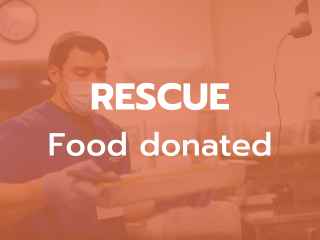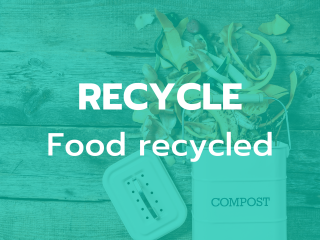A baseline audit is a key first step in your food waste work that will help you identify the sources of wasted food so you can deploy the most applicable strategies. For example, food wasted due to overproduction would be targeted for source reduction and donation.
“If you can do something to reduce the waste, you’re doing the right thing for the environment, you’re saving money, and you’re doing something socially responsible. It’s a win-win-win all the way around.”
– Tom Thompson, UW Health
You can conduct your audit manually or by using a technology-enabled solution. Technology-enabled waste tracking is increasingly accessible and highly effective in identifying and supporting strategies to maximize environmental, financial, and social benefits.

“I have my sous chefs weighing and tracking every day. This way they take ownership. They are touching and feeling, and the shock has helped motivate them. I don’t think anyone realized how much food and money was being thrown away until we started tracking it and writing it down.”
– Vanessa Gray-Douglas, Harborview Medical Center
Manual
To conduct a manual audit you will need a scale, bins or buckets for weighing, a logging sheet, and a trained staff member or members to conduct the tracking.
- Set the parameters. For example, parameters can include kitchen waste, cafeteria plate waste, patient plate waste, and catering.
- Set a time period. Typical data collection periods are one day, three days, or seven days. Setting a longer time period gives you more accurate data.
- Sort and weigh food, noting the elements in the table below, and enter your data into our waste tracker tool.
- Calculate your totals.
Important elements to track in a baseline of wasted food
| Category of food | Quantity | Cause of loss | Edible vs inedible | Destination |
|
e.g., soup/stew, raw produce, dry goods, poultry |
e.g., 5 pounds |
e.g., overproduction, spoilage, plate waste | to determine opportunity for donation | e.g., compost, landfill, donation |
Technology-enabled
“Technology-enabled tracking improves accuracy and efficiency of data collection, leading to better insights and quicker turnaround…[it] informs and optimizes operations, increasing profits, eliminating waste, and forming the business case for investment in other food waste solutions.”
– ReFED
Examples of technology-enabled tracking programs used by Practice Greenhealth partners are:
- Gundersen Health used Leanpath, an international technology solutions provider focused on preventing food waste in food service operations through measurement, data analytics, and behavior change.
- Sutter Health uses Copia, which allows businesses nationwide to safely donate their excess food, access enhanced tax deductions, and receive powerful data to inform food purchasing decisions.
- UCSF Health uses RePlate, a food rescue technology platform where businesses can schedule on-demand pickups for their surplus food.
- Several Practice Greenhealth partners track their waste data with consultants or other software providers.
Analyze the results
Use the data to build your case and develop a waste reduction plan utilizing the three strategies.
- Foods wasted by overproduction and spoilage should be targeted for reduction.
- Edible foods not captured through reduction strategies should be targeted for rescue.
- Inedible foods not captured through reduction strategies should be targeted for recycling.
ReFED’s impact calculator will translate data into environmental and social impacts of alternative food recovery strategies.
“We found it more tedious to use a tech tracking service than to do manual recording. We developed our own spreadsheet that was easier for the staff to use. We set prices with everything, and it ended up being more successful for us.”
– Jill Martin, UC San Diego Health
Track progress toward your goal
Tracking your progress in reducing food waste is important for understanding how you are progressing toward the 50% reduction goal. This data can also help you understand how your work is contributing to your organization’s larger goals and gain recognition for progress through Practice Greenhealth Environmental Excellence awards. Your food waste data can show how reductions contribute to:
- Climate goals
- Internal solid waste goals
- Community health/community benefit goals
Tracking reductions in food waste can be tricky. For example, when you start a composting program, you will want to see composting numbers go up. However, as you advance your source reduction strategies, composting numbers will go down because you are reducing the amount of food waste generated in the first place. Looking just at compost numbers over time is not necessarily an accurate way to assess your food waste program’s overall progress.
One methodology for tracking food waste uses total food purchases and total sales to estimate food waste generated. Health Care Without Harm and Practice Greenhealth are working with ReFED to create a calculator based on this methodology.
Another method for tracking your progress is conducting an annual waste audit using our waste tracker tool. This will help you understand progress in each food waste category and refocus your efforts on the most impactful strategies.
Additionally, each strategy has its own unique metrics you can use to evaluate its effectiveness. Revisit your targets regularly as your program matures. Donation and recycling numbers will go down as your source reduction strategies are more successful.
You may also wish to compare your data to similar health systems and hospitals using our benchmark reports.



